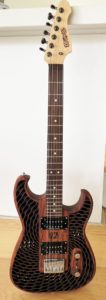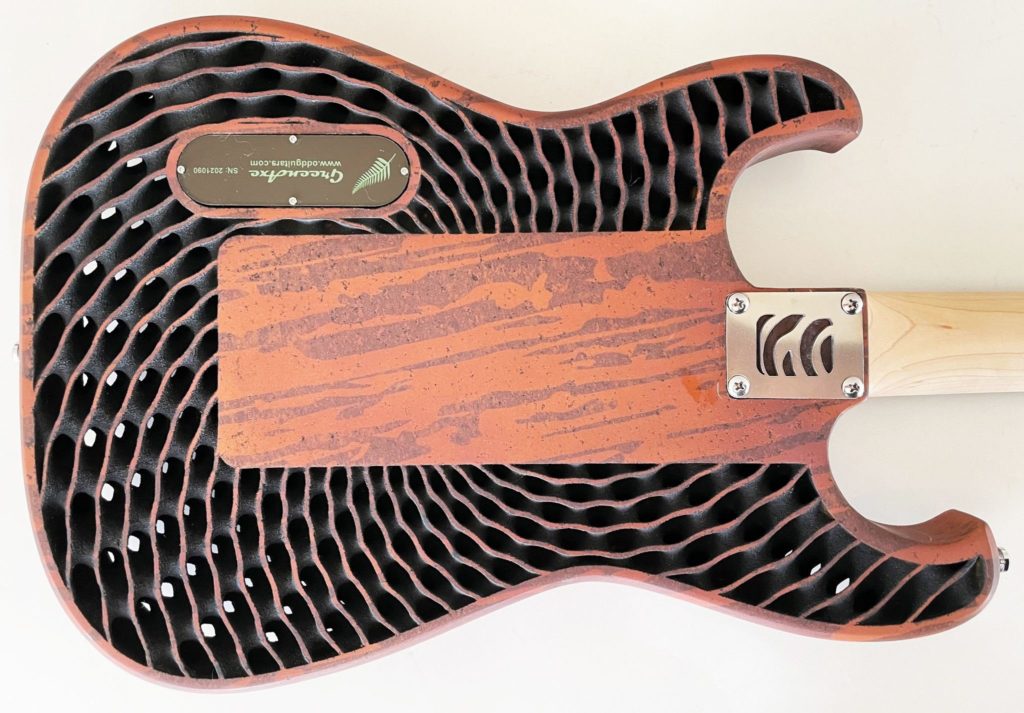While you can’t yet purchase a wood binder jetting system from Desktop Metal quite yet, you can buy a handful of 3D printed wood items on the Forust website. You can even reach out to the company for your own specialty projects. Those who’ve been following the work of Olaf Diegel might have guessed what projects he might have had in mind. Nevertheless, it was a pleasant surprise when Desktop Metal CEO Ric Fulop tweeted the most recent 3D printed guitar from our favorite 3D printing musician, designer, and University of Auckland professor.
My friend Olaf Diegel at Wohlers Associates just sent me pics of this amazing guitar printed with https://t.co/8W68d3Bb1H and it’s absolutely stunning! 🕶🚀. Looks like it was designed in @nTopology cc/ @brad_rothenberg pic.twitter.com/ROcBxamBQ3
— Ric Fulop 🚀 (@ricfulop) November 24, 2021
Olaf’s latest creation was 3D printed using Desktop Metal’s Forust process, which the professor tells us isn’t all too different from the gypsum binder jetting made famous by Zcorp and 3D Systems. Due to the size of the guitar, it was produced not on the modified Shop System from Desktop Metal, but on an R&D machine.

Olaf Diegel’s 3D printed wood guitar, made using Desktop Metal’s Forust process. Image courtesy of Ric Fulop on Twitter.
“The commercial system is not quite big enough to do a guitar body. But their upcoming robot arm-based binder jetting system will be once it’s fully developed,” Diegel said. “[The technology] more or less works the same as the old ZCorp machines, where we printed in gypsum with a binder that created a green part, and the parts where then infiltrated with cyanoacrylate or thinned down epoxy to strengthen them,” Diegel said. “The Forust process used for the guitar was very much the same. The wood sawdust was first bound together with a green-part binder (with two different colors), sanded down, and then infiltrated with a bio-epoxy as a secondary process. It was finally dyed to give it the right wood color.”
Diegel revealed that Desktop Metal is advancing the technology so that the epoxy is printed directly onto each layer of sawdust. “[This] will make the process infinitely more versatile and controllable. It’s the controllability that is important to me as, for a guitar, you want to be able to very precisely control what goes where, material density, etc. That’s always a challenge with post-infiltration, as you don’t really know how far into the part it has infiltrated. So, printing the epoxy directly would resolve this. And, of course, the ability to then print several different epoxy colors would make for a much more realistic woodgrain.”

Olaf Diegel’s 3D printed wood guitar, made using Desktop Metal’s Forust process. Image courtesy of Ric Fulop on Twitter.
Typically, Olaf has 3D printed most of his guitars with selective laser sintering (SLS), though he has also produced two using aluminum powder bed fusion and some colorful guitars with material jetting on a Mimaki system.
The engineer told 3DPrint.com that the cost to print the body was just US$540. That is an extremely reasonable price given the fact that a mass-manufactured beginner-to-intermediate electric guitar may be available for that price point. A custom instrument would necessarily be made by hand and cost upwards of $1,000 to $2,000. Unfortunately, due to the weight of the piece and Olaf’s remote location of Auckland, New Zealand, it cost $380 to ship.
“The print cost is less than to do them in SLS, which ranges anywhere from EUR700 to EUR1000 depending on the size of the body. I usually print them either through i.materialise or Shapeways, as none of my machines are big enough for a guitar,” Diegel said.
“From my point of view, it doesn’t t really matter too much which process I use, so long as it’s strong enough, and providing I understand enough about the intricacies of the process so that I can design for it the right way,” Diegel said. “But I just love the idea behind the [Forust] process of being able to use waste material to produce something of value! So, as they develop their newer systems, I’ll definitely be printing a few more design with them.”
As noted on 3D Printing Media Network, the design was made using SOLIDWORKS and nTop software. It features “with Seymour Duncan hot-rodded humbuckers, Schaller bridge and switch, Gotoh tuners, and a Warmoth maple/rosewood neck.” The result is an intricate geometry only possible with 3D printing. The lattice structure should also reduce the overall weight of the instrument. If the Forust process is truly sustainable, this could be extremely disruptive for custom goods, guitars or otherwise.

Olaf Diegel’s 3D printed wood guitar, made using Desktop Metal’s Forust process. Image courtesy of Ric Fulop on Twitter.
Woodworking is a skill not everyone has, allowing craftspeople to charge significantly for their well-earned expertise. However, if those same woodworkers can bring down their rates by reducing labor, this technology could allow them to undercut their competitors. Not only could you purchase a custom guitar for a half or quarter of the price, but you could even restore classic wood pieces.
Say an element breaks off of an heirloom hutch from the early 20th century. You could 3D scan it and produce a suitable replacement that can then be finished with traditional finishing techniques. Of course, it won’t necessarily be made from the same material as the original, but for most people, it’s the look that counts and those with big checkbooks can afford a hand-crafted replacement.
As you might be able to tell, I’m extremely excited by the possibilities of this technology. Because Desktop Metal is still a new company that may be relying on its acquisitions of EnvisionTEC and ExOne to drive the ship forward while the rest of its operations are fully up and running, we still have to hold our breathes with regard to a commercial release of Forust machines. When they are released, it could have a major impact on all things wooden.
For the time being, the best way for customers to contact Forust for any specialty projects is to reach out via the link to “upload your own design” on the Digifabster website here or submit an inquiry regarding potential high-volume production partnerships here.
Subscribe to Our Email Newsletter
Stay up-to-date on all the latest news from the 3D printing industry and receive information and offers from third party vendors.
You May Also Like
3D Printing Webinar and Event Roundup: May 5, 2024
We’ve got a busy week of 3D printing events ahead of us, in Texas, Florida, Washington, D.C., Shanghai, and more. Webinar offerings will cover medical models, PolyJet 3D printing, additive...
High Stakes, High Speed: KVG Acquires 15 Nexa3D HSE 3D Printers to Boost Military Tech
As 3D printing increasingly intersects with defense and military logistics, a new partnership between Nexa3D and mission support logistics firm KVG stresses the growing importance of this technology in strategic...
Construction 3D Printing CEO Reflects on Being Female in Construction
Natalie Wadley, CEO of ChangeMaker3D, could hear the words of her daughter sitting next to her resounding in her head. “Mum, MUM, you’ve won!” Wadley had just won the prestigious...
3D Printing News Briefs, February 17, 2024: Shot Blasting, Service Bureaus, & More
In today’s 3D Printing News Briefs, we’re starting out with post-processing, as SKZ Würzburg is using a shot blast system from AM Solutions for its research. Moving on to business,...































